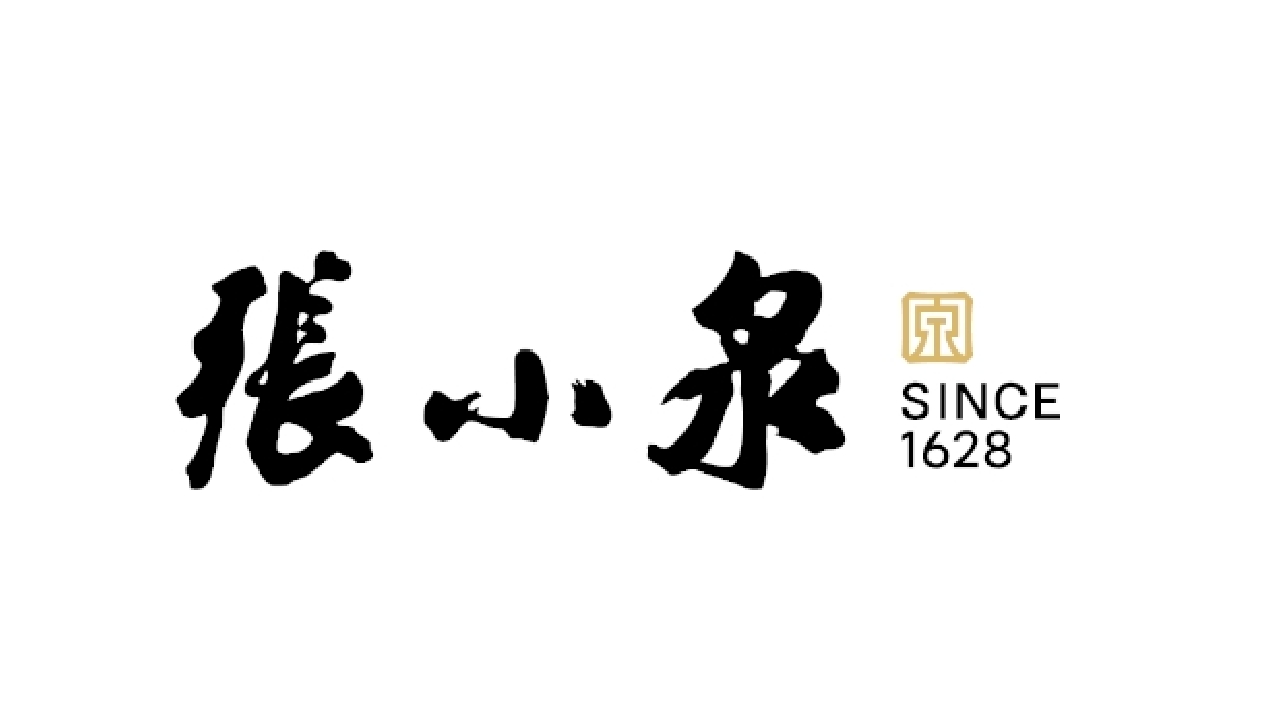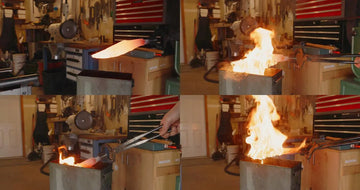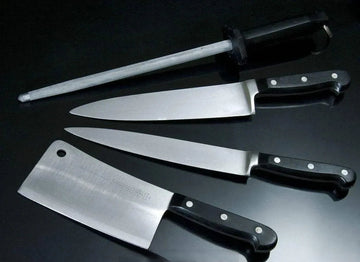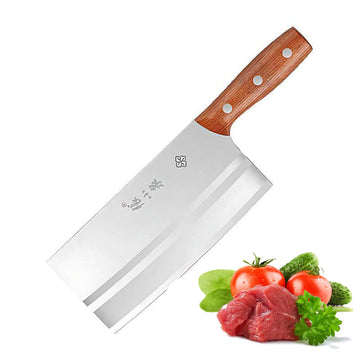How to Choose the Perfect Kitchen Knife: A 4-Point Checklist
When skills need backup, tools step up. A quality kitchen knife turbocharges your cooking efficiency while boosting culinary confidence. Chef's criteria for a great knife:
-
Sharp & Long-lasting
Holds edge - no daily sharpening needed -
Low-Maintenance
Rust-resistant with minimal upkeep -
Ergonomic Design
Naturally balanced grip for precise control -
(Bonus) Aesthetic Appeal
Beauty that works hard without pretense
Let's break down the knife selection process through four key lenses:

What's the best kitchen knife type for home use?
Kitchen knives fall into three main categories:

For everyday Chinese cooking, the ideal knife set combines:
- Chinese Cleaver + 2. Bone Chopper + 3. Multi-Purpose Knife
1. Chinese Cleaver (Wen Dao)
- Most used knives in Chinese kitchens
- Tasks: Slicing meat/vegetables, creating thin cuts/shreds
- Handles all soft ingredients
- 🚫 Avoid: Cutting bones/hard materials
2. Bone Chopper (Wu Dao)
- Heavy-duty companion to slicing knife
- Features: Thick blade, durable edge
- Tasks: Chopping bones (chicken/pork/seafood)
- 💡 Tip: Keep separate from precision knives
3. Western & Japanese Knife
- Options:
• Western Chef's Knife (8")
• Santoku Knife (Japanese all-purpose) - Uses:
• Safe handling of cooked foods/fruits
• General slicing/dicing (raw ingredients when needed) - Ideal for: Home cooks & beginners
Usage Strategy
| Task | Tool |
|---|---|
| Daily vegetable prep | Chinese Cleaver |
| Bone/meat processing | Bone Chopper |
| Ready-to-eat foods | Multi-Purpose Knife |
How to pick a long-lasting sharp Chinese Kitchen knife?
A knife's sharpness, edge retention, and corrosion resistance all come down to one thing - the steel it's made from.

Don't fall for market tricks like hair-splitting demos or chopping water streams. Those are circus acts. Real cooks check steel grades. Here's the straight talk:
Most Chinese knives use stainless steel. Look at the carbon content:
- Low-carbon (soft, dulls fast)
- Medium-carbon (decent edge)
- High-carbon (what pros use)
More carbon = harder steel. A properly sharpened high-carbon blade cuts cleaner, holds its edge longer, and won't need constant maintenance. Stick with high-carbon steel.
Steel Types
Low-carbon: 30Cr13 (3Cr13), 300-series (304/316), 400-series (410/420/430)
Mid-carbon: 50Cr15MoV (5Cr15MoV), 1.4116
High-carbon: 90Cr18MoV (9Cr18MoV), 440-series, VG10, AUS-10
Low-Carbon Steel (≤0.30% C)
Under 0.3% carbon. Hardness ~52HRC (Rockwell hardness). Includes 3Cr13 (now called 30Cr13), 300-series (304/316), 400-series (410/430).
Budget-friendly steel that shapes easily, takes a quick edge but dulls fast. Prone to rust. Used for cheap kitchen beaters or everyday tools like paring knives.
Mid-Carbon Steel (0.3%-0.6% C)
0.3-0.6% carbon. Hardness ~56HRC. Examples: 5Cr13 (now 50Cr13), German 1.4116.
Goldilocks steel – not too soft, not too brittle. Holds an edge better than low-carbon. Made for bone cleavers and heavy-use blades that need shock resistance.
High-Carbon Steel (>0.6% C)
Over 0.6% carbon. Hardness starts at 58HRC:
- Chinese: 9Cr18MoV (now 90Cr18MoV)
- Western: 440A/B
- Japanese/German: VG10, AUS-10 (1%+ carbon, 60HRC)
These are your razor blades. Stays sharp through 100 lbs of veggies, resists rust, laughs at wear. Requires proper care – dry after use, hone regularly. Pro-choice for slicers and precision work.
Beyond carbon, we add these elements to make better knife steel:

Chromium (Cr): Stops rust. More chromium means better rust resistance.
Molybdenum (Mo): Hardens the steel and resists pitting in salty conditions (like when cutting seafood). Basically extra rust protection.
Vanadium (V): Makes steel grains tighter. This strengthens the metal while keeping it flexible. Makes blades sharper and longer-lasting.
Here's how real chefs talk about steel grades:
Low-Carbon 3Cr13 (New : 30Cr13)
- 30 = 0.3% carbon (good for basic use)
- Cr13 = 13% chromium (rust-resistant)
Mid-Carbon 5Cr15MoV (New: 50Cr15MoV)
- 50 = 0.5% carbon (holds an edge better)
- Cr15 = 15% chromium (better rust protection)
- Mo = Molybdenum (tougher blade)
- V = Vanadium (stays sharp longer)
High-Carbon 9Cr18MoV (New: 90Cr18MoV)
- 90 = 0.9% carbon (razor-sharp edge)
- Cr18 = 18% chromium (almost stainless)
- Mo = Molybdenum (extra toughness)
- V = Vanadium (edge lasts through heavy use)
Ultimate Chef Combo
- Mid-carbon bone chopper (takes abuse)
- High-carbon slicer (paper-thin cuts)
- High-carbon multi-tasker (does everything else)
This setup gives you blades that stay sharp, won't rust if wiped dry, and won't have you constantly at the sharpening stone. Just remember - high carbon means NO dishwasher, EVER. Hand wash and dry immediately.
What Makes a Chinese Chef Knife Feel Right?
A knife feels right when it balances well, has proper weight, and fits comfortably in your hand.
Balance Matters
Balance means how the blade weight matches the handle. Good balance makes cutting smoother and saves your energy.
By lever mechanics, the balance point usually sits where the blade meets the handle. If it leans forward, the blade's own weight helps push through ingredients – making chopping feel powerful. If it leans backward, the knife becomes more nimble for quick moves.
Longer blades (18-20cm ideal) need heavier handles to balance. Keep blade width under 10cm – any wider and the knife gets clumsy.
For bone choppers and slicers: a slightly blade-forward balance gives better control. For all-purpose knives: neutral balance works best – not too heavy, not too light.
Weight
A kitchen knife's heft makes or breaks your cutting game. Too light and it won't bite through ingredients; too heavy and your wrist will cry uncle. Different jobs need different weights.
Bone Chopper: 600g sweet spot. You need that raw power to split through bones in one swing.
Slicing Knife: 400g range works best. Guys might go 20g heavier, ladies 20g lighter. Keep it between 350-450g.
Multi-Purpose: 200g is Goldilocks weight. Lets you flip between tasks without wearing out your arm.
Handles
Handles need ergonomic shaping - comfortable grip that doesn't slip.
Wood handles come first. Natural grip feels best in the hand but needs regular oiling to avoid moisture damage. Plastic/composite handles last longer and clean easily, but get sticky when sweaty. Full-metal handles make the knife too heavy, Don't bother.
Why do Chinese kitchen knives vary so much in price?
Two main factors decide a knife's cost: materials and craftsmanship.
Materials
We talked about materials in Section 2 - low-carbon steel, medium-carbon steel, and high-carbon steel. These correspond directly to budget, mid-range, and premium knives. Better steel means higher prices, especially when more of it's used.
Now some folks might ask: Why do some high-carbon steel knives cost peanuts while others cost thousands?
There's an old saying: "Good steel belongs on the blade's edge." Is any knife around $30 claiming high-carbon steel? Only the cutting-edge uses the good stuff. The rest is cheap low-carbon steel. Smart trick - keeps the blade sharp longer without breaking the bank.
Those $200 knives? Full high-carbon steel body. But beyond materials, what you're really paying for is the hand-forged craftsmanship.
Handmade or Not
How much hands touch the steel changes the price tag.
Let's break down how kitchen knives get made:
Pick steel -> Cut shapes -> Forge -> Quench -> Temper -> Grind -> Polish -> Handle install -> Quality check
Three ways they're made:
Machine-made
Every step is done by machines - cutting, forging, heat treatment, you name it. Cheap to make, and super consistent. Feels like every knife's identical.
Semi-handmade
Machines do the heavy hitting (forging, quenching), and then human hands take over grinding and polishing. Better quality control than full machine-made blades. Best bang for your buck.
Full-handmade
Blacksmiths swing hammers for every step. Each blade's got a personality - no two are exactly alike. Cuts like a dream but costs a month's grocery money. For pro chefs and knife nerds only.
Bottom line? Semi-handmade hits the sweet spot for home cooks. Does the job without emptying your wallet.
II. Best Bang-For-Your-Buck Chinese Chef Knives
Here are my straight-from-the-kitchen recommendations based on years of actual use. No fluff - just good blades that won't empty your wallet:
1. The Real Deal Chinese Cleaver

Zhang Xiaoquan's Chopper knife uses 50Cr13(5Cr13) medium-carbon steel. It can handle veggies and bones, holds its edge well and lasts long. Compared to common 30Cr(3Cr) low-carbon steel slicers, you get more value.

This Chinese cleaver's been tuned and perfected through countless tweaks - near-perfect balance now. The affordable all-rounder most home cooks recommend for everyday chopping.
Sanmai lamination construction. Blade's 95Cr18MoV high-carbon steel, body's softer iron core. The razor-sharp edge stays that way. Tough as nails, rust-resistant. 443g total weight - works for all hands, moves like it's part of your arm. Oh, and unlike those clunky old cleavers? This one actually looks sharp sitting on your counter.
2. The High Price Kitchen Knife

The blade's VG-MAX steel – upgraded VG10 version. Top-tier hardness, sharpness, flexibility, durability. Hand-forged with 32-layer Damascus patterns on both sides. Looks as good as it cuts.

Tojiro Santoku. Sanmai clad blade (soft outside, hard core). Edge is VG10 high-carbon steel from Takefu Special Steel, the body's cobalt alloy. Gets sharp, bends well, and lasts long. Only 150g - light enough for women cooks. Front slices herbs, middle chops pork belly, back smashes garlic. Good for all kitchen jobs.
Final word to all cooks:
Master the steel basics from Part 1. That’s your cheat code for spotting good blades.
Remember this like your wok’s fire temperature: Use knives as they’re meant to be used. Different blades for different tasks. Don’t make your blade work beyond its job. Edge wear is manageable – chips mean your blade’s done for.
Even premium knives demand care. Wipe them bone-dry after use – “stainless” doesn’t mean rust-proof. High-carbon steel? Coat it with cooking oil before long storage.
That’s my kitchen wisdom – use it well.






